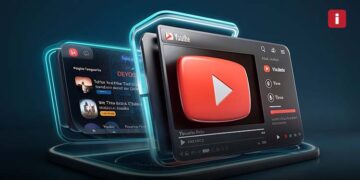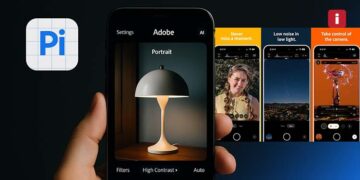Welcome to the Next Era of Visual Computing
The digital world is constantly evolving, but some innovations are so transformative they redefine entire industries. One such innovation is the rise of holographic displays for laptops and smartphones—a field once reserved for science fiction, now making serious waves in real-world technology.
In 2025, the boundaries between the physical and digital world are dissolving. As spatial computing, AI, and display technologies converge, holographic displays are emerging as the next step in immersive interaction. Forget flat screens—this is about interactive visuals that appear to float, move, and respond in real 3D space.
At Insight Tech Talk, we dive deep into how holographic displays for laptops and smartphones are reshaping the tech landscape, who’s leading the charge, what the current limitations are, and how this innovation may soon be part of your everyday digital experience.
What Are Holographic Displays? A Quick Primer
A holographic display refers to a technology that enables users to view 3D images without the use of special glasses or headsets. Unlike augmented reality (AR), which requires wearable devices, holographic displays project volumetric images that exist visibly in real space.
These displays use technologies like:
- Light field projection
- Micro-lens arrays
- Eye-tracking and head-tracking
- AI-based depth rendering
They create depth by projecting different images to each eye, enabling a realistic 3D experience. Users can walk around or move their head and see different perspectives of the same object—just like in the real world.
The implications for holographic displays for laptops and smartphones are massive. It opens up a new dimension of interaction, literally and metaphorically.
Why Are Holographic Displays Trending Now?
We are at a convergence point where enabling technologies are mature enough to support advanced holography:
1. Powerful Mobile GPUs and AI Chips
Laptops and smartphones now come with high-performance GPUs and NPUs that can render 3D content in real time.
2. Advancements in Light Field & Lenticular Displays
Manufacturers have improved the fidelity of displays that can emit light in multiple directions for different viewing angles.
3. 5G & Edge Computing
With reduced latency and higher bandwidth, holographic rendering can be delivered via the cloud, reducing the load on devices.
4. User Expectations of Immersive UX
From AR filters to VR headsets, users have developed a taste for spatial experiences. Holography offers a seamless, wearable-free bridge.
Key Applications of Holographic Displays in Laptops and Smartphones
Let’s explore how this technology is being applied across different sectors:
1. 3D Design and Architecture
Professionals can visualize and interact with their models in 3D space—rotate, resize, or walk around them—without VR gear.
2. Medical Imaging
Doctors can now view organs, scans, and surgical plans as 3D holograms, helping in better diagnosis and preparation.
3. Gaming and Entertainment
Games can leap off the screen, while movies and music videos could be viewed with characters performing in 3D above your phone.
4. Holographic Video Calls
Forget flat Zoom calls. Holographic calls can bring lifelike representations of people into your living room or workspace.
5. E-Commerce and Retail
Online shopping will get an upgrade as users view 3D holograms of clothes, shoes, or gadgets before buying.
Top Companies Building Holographic Displays for Laptops and Smartphones
Let’s look at the companies leading innovation in this space.
1. Leia Inc.
Leia is one of the pioneers in light field technology. Their Lume Pad 2 is a tablet that offers real-time 3D viewing without glasses. They have also introduced the Leia App Store, where 3D apps are optimized for holographic viewing.
2. Looking Glass Factory
Though focused more on desktop displays, Looking Glass is developing scalable 3D display solutions. Their light field tech is already used in medical visualization and 3D asset development.
3. Apple
Apple has been filing patents and acquiring companies related to spatial and holographic displays. With the launch of the Apple Vision Pro, many expect the iPhone or MacBook to integrate holographic display elements in future releases.
4. Samsung
Samsung has consistently teased futuristic displays—from foldables to rollables. Rumors point to their work on 3D holographic interfaces, especially for premium Galaxy devices.
5. Red Digital Cinema (Hydrogen One)
Though it was commercially unsuccessful, the Hydrogen One smartphone was one of the first to attempt holographic viewing. Its legacy still inspires new R&D in this space.
6. Sony
Sony’s Spatial Reality Display allows for 3D viewing without glasses and has found a niche in design studios and concept visualization.
The Tech Stack Behind Holographic Displays
Let’s break down the tech that powers these holographic marvels:
1. Light Field Display Technology
Captures and displays light at multiple angles, allowing viewers to see different perspectives depending on their position.
2. Lenticular Lens Arrays
Uses tiny lenses to direct light to each eye independently, creating a stereoscopic effect.
3. Eye and Head Tracking
Enables dynamic adjustments to the image perspective based on where the viewer is looking.
4. Spatial Audio
Combining visuals with 3D sound provides a more immersive experience.
5. AI Rendering
Deep learning helps to interpolate depth, adjust angles, and simulate realistic motion in real time.
Holographic Laptops: Transforming the Workspace
We are now seeing laptops with embedded holographic displays that redefine productivity:
- Developers can test 3D UI/UX without VR headsets.
- Engineers can manipulate 3D prototypes during Zoom calls.
- Digital artists can sketch in 3D space using styluses and gesture controls.
The rise of holographic displays for laptops signals a shift from flat UX to fully spatial work environments.
Smartphones as Holographic Portals
Smartphones, with their always-on nature and portability, are perfect for introducing holography to the masses.
Upcoming innovations may include:
- Holographic selfies and social content
- 3D avatars for messaging
- Hologram-based games like chess or Pokémon GO-style interactions
- Interactive 3D ads and AR-powered eCommerce
As developers start designing with 3D in mind, we can expect app ecosystems that support true holographic interfaces.
Challenges and Limitations
Despite the excitement, several challenges remain before this technology becomes mainstream:
1. Cost and Accessibility
Most current models are expensive, limiting widespread adoption.
2. Content Ecosystem
We still lack robust ecosystems for 3D apps, holographic media, and development tools.
3. Resolution and Brightness
Holographic displays tend to compromise pixel density and brightness to support depth.
4. Processing Power
Rendering 3D holography in real-time requires high-end processors and often drains the battery quickly.
5. Standardization
With no unified standards, it’s hard for developers to create universally compatible content.
What the Future Holds
The future of holographic displays for laptops and smartphones is deeply tied to the evolution of spatial computing. As companies invest more into AI, AR, and next-gen UI, we are moving toward a world where:
- Screens won’t be a barrier—they’ll become windows into other dimensions.
- Interactivity will be 3D-native, making design, entertainment, and education more intuitive.
- Mobile computing will become immersive, portable, and context-aware.
Imagine editing a movie in 3D space, having a lifelike conversation with a family member who appears as a hologram on your phone, or designing architecture with floating models you can walk around.
Conclusion: A Future Beyond the Flat Screen
Holographic displays for laptops and smartphones aren’t just another tech trend—they are a paradigm shift in how we interact with the digital world. At Insight Tech Talk, we believe the age of flat screens is nearing its twilight. The next wave of computing will be spatial, interactive, and deeply immersive.
While the path ahead includes technical, economic, and design challenges, the groundwork is already in motion. For tech enthusiasts, content creators, and everyday users, the promise of holography is too powerful to ignore.
The real question isn’t if it will happen—but when you’ll see your first holographic device.
Want more tech news, in-depth insights, and future-forward updates? Follow Insight Tech Talk and stay ahead of the curve.













































